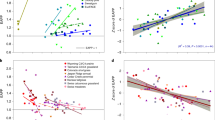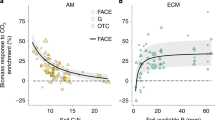Abstract
The decade-long USA research program on the direct effects of CO2 enrichment on vegetation has achieved important milestones and has produced a number of interesting and exciting findings. Research beginning in 1980 focused on field experiments to determine whether phenomena observed in the laboratory indeed occurred in natural environments. The answer is yes. Data obtained from numerous field studies show mixed response of crop and native species to CO2 enrichment however. Nearly all experiments demonstrate that plants exhibit positive gain when grown at elevated CO2; although the magnitude varies greatly. Most crop responses range from 30 to 50 % increase in yield. Results from long-term experiments with woody species and ecosystems are even more variable. Huge growth responses (100 to nearly 300 % increase relative to controls) are reported from several tree experiments and the salt-marsh ecosystem experiment. Other results from experiments with woody species and the tundra ecosystem suggest little no effect of CO2 on physiology, growth or productivity. Numerous studies of the physiology of the CO2 effect are continuing in attempts to understand controlling mechanisms and to explain the variable growth responses. Particular emphasis needs to be given to physiological measures of interactions involving the CO2 effect and other environmental influences, and to the wide-ranging observations of photosynthesis acclimation to CO2. Prospects for future research are identified.
Similar content being viewed by others
References
Amthor, J. S. 1991. Respiration in a future, higher-CO2 world. Plant, Cell Environ. 14: 13–20.
Amthor, J. S., Koch, G. W. & Bloom, A. J. 1992. CO2 inhibits respiration in leaves ofRumex crispus L. Plant Physiol. 98: 759–760.
Arp, W. J. 1991. Effects of source-sink relations on photosynthetic acclimation to elevated CO2. Plant, Cell Environ. 14: (In press).
Arp, W. J. & Drake, B. G. 1991. Increased photosynthetic capacity ofScirpus olnei after four years of exposure to elevated CO2. Plant Cell Environment 14(9).
Bazzaz, F. A. 1990. The response of natural ecosystems to the rising global CO2 levels. Ann. Rev. Ecol. Syst. 21: 167–196.
Bunce, J. 1990. Short and long-term inhibition of respiratory carbon dioxide efflux by elevated carbon dioxide. Ann. Bot. 65: 637–642.
Campbell, W. J., Allen, L. H.Jr. & Bowes, G. 1988. Effects of CO2 concentration on rubisco activity, amount and photosynthesis in soybean leaves. Plant Physiology 88: 1310–1316.
Chen, J. J. & Sung, J. M. 1990. Gas exchange rate and yield responses of virginia-type peanut to carbon dioxide enrichment. Crop Science. 30: 1085–1089.
Conroy, J. 1989. Influence of high CO2 onPinus radiata, Ph. D. Thesis, Maqauerie Univ, School of Biological Sciences.
Dahlman, R. C. 1983., Strain, B. R., & Rogers, H. H. 1985. Research on the response of vegetation to elevated atmospheric carbon dioxide. J. Environ. Qual. 14: 1–8.
Dahlman, R. C. 1984. Vegetation Response to Carbon Dioxide: Research Plan. DOE/ER-0187. pp 32.
Delucia, E. H., Sasek, T. W. & Strain, B. R. 1985. Photosynthetic inhibition after long-term exposure to elevated levels of atmoshheric carbon dioxide. Photosynthesis Research 7: 175–184.
Downton, W. J. S., Bjorkman, O. & Pike, C. S. 1980. Consequences of increased atmospheric concentrations of carbon dioxide for growth and photosynthesis of higher plants.In Pearman, G. I., ed. Carbon Dioxide and Climate. Australian Academy of Science, Canberra. pp. 143–151.
Drake B. G. 1989. Elevated atmospheric CO2 concentration increases carbon sequestering coastal wetlands. Dept of Energy Research Project of the Month, October 1989. 3 pp. (available from CDIAC, P. O Box X, Oak Ridge TN, 37830).
Drake, B. G., Ziska, L. H. Bunce, J. A., Arp, W. J., Hogan, K., Smith A. P. Dark respiration in plants grown in the field exposed to elevated atmospheric CO2. Submitted to Plant, Cell Environ.
Ehret, D. L. & Jolliffe, P. A. 1985. Photosynthetic carbon dioxide exchange of bean plans grown at elevated carbon dioxide concentrations. Can J. Bot. 63:2026–2030.
Hendrey, G. R., Kimball, B. 1990. FACE: Free-air carbon dioxide enrichment; Application to field-grown cotton. BNL Report 46155. 17 pp.
Houghton, J. T., Jenkins, G. J., & Ephraums, J. J. 1990. Climate Change: The IPCC Scientific Assessment. Cambridge Univ Press, Cambridge.
Idso, S. B., Kimball, B. A., Anderson, M. G., & Mauney, J. R. 1987. Effects of atmospheric CO2 enrichment on plant growth: The interactive role of air temperature. Agric. Ecosystems Environ. 20: 1–10.
Idso, S. B., Kimball, B. A. 1991. Effects of two and a half years of atmospheric CO2 enrichment on the root density distribution of three-year-old sour orange trees. Agric. For. Meterol. 55: 345–349.
Jarvis, P. G. 1989. Atmospheric carbon dioxide and forests. Phil. Trans. Roy. Soc. Lond. B 324: 369–392.
Keeling, C. D., Bacastow, R. B., Carter, A. F., Piper, S. C., Whorf, T. P., Heimann, M., Mook, W. G., & Roeloffzen, H. 1989. A three dimensional model of atmospheric CO2 transport based on observed winds: 1. Analysis of observational data.In: Aspects of climate variability in the Pacific and the Western Americas, D. H., Peterson (ed), Geophysical Monograph 55, AGU, Washington (USA), 165–236.
Kimball, B. A. 1983. Carbon dioxide and agricultural yield: an assemblage and analysis of 430 observations. Agron. J. 75: 779–788.
Kimball, B. A. 1985a. Carbon dioxide stimulation of growth and yield under environmental restraints. In: Enoch, H. Z. & Kimball, B. A. (eds), CO2 Enrichment of Greenhouse Crops, CRC Press, Boca Raton, FL.
Kimball, B. A. 1985b. Influence of elevated CO2 on crop yield. In: Enoch, H. Z. & Kimball, B. A. (eds), CO2 Enrichment of Greenhouse Crops, CRC Press, Boca Raton, FL.
Kriedemann, P. E. & Wong, S. C. 1984. Growth response and photosynthetic acclimation to CO2; comparative behavior in two C3 crop species. Acta Hort. 162: 113–120.
Lemon, E. R. (ed) 1983. CO2 and Plants: The Response of Plants to Rising Levels of Atmospheric Carbon Dioxide. AAAS Selected Symposium 84. 280 pp.
Lincoln, D. E., Couvet, D., Sionit, N. 1986. Response of an insect herbivore to host plants grown in enriched carbon dioxide atmospheres. Oceologia 69: 556–560.
Norby, R. J. 1991. Response of white oak and yellow poplar in a two-year field CO2 experiment. Personal communication. (Note: the yellow poplar data are also reported in Norby, R. J., C. A. Gunderson, S. D. Wullschleger, E. G. O'Neill and M. K. MacCracken. Productivity and compensatory responses of yellow poplar trees in elevated CO2. Nature (in press).
Norby, R. J., O'Neill, E. G. 1991. Leaf area compensation and nutrient interactions in CO2-enriched seedlings of yellow-poplar (Liriodendron tulipifera L.) New Phytol. 117: 515–528.
Norby, R. J., O'Neill, E. G., Luxmore, R. J. 1986. Effects of atmospheric CO2 enrichment on the growth and mineral nutrition ofQuercus alba seedlings in nutrient poor soil. Plant Physiol. 82: 83–89.
Project Steering Group (R. Revelleet al.). 1980. Carbon Dioxide Effects Research and Assessment Program (013): Environmental and Societal Consequences of a Possible CO2-Induced Climate Change: A Research Agenda. US Dept of Energy Report DOE/EV/10019-01.
Radin, J. W., Kimball, B. A., Hendrix, D. L. & Mauney, J. R. 1987. Photosynthesis of cotton plants exposed to elevated levels of carbon dioxide in the field. Photosynthesis Research 12: 191–203.
Sage, R. F., Sharkey, T. D. & Seeman, J. R. 1989. Acclimation of photosynthesis to elevated CO2 in five C3 species. Plant Physiology 89: 590–596.
Strain, B. R. 1978. Report of the Workshop on Anticipated Plant Responses to Global Carbon Dioxide Enrichment, Duke Univ, Durham N. C. (Quail Roost Meeting), 91 pp.
Strain, B. R. 1991. SOA Major Findings. Personnel Communication, November, 1991. 3 pp.
Strain, B. R. & Cure, J. D., eds. 1985. Direct Effects of Increasing Carbon Dioxide on Vegetation. U. S. Department of Energy Report DOE/ER-0238, 286 pp. This report contains the following chapters:
Background on the Response of Vegetation to Atmospheric CO2 Enrichment,B. R. Strain, pp 1–10.
Methods of Exposing Plants to Elevated CO2,B. G. Drake, H. H. Rogers, & L. H. Allen Jr., pp 11–32.
Modeling Approaches for Evaluating Vegetation Responses to CO2 Concentration,J. F. Reynolds & B. Acock, pp 33–52.
Crop Responses to Elevated Carbon Dioxide Concentrations,B. Acock & L. H. Allen Jr., pp 53–98.
CO2 Doubling Responses: A Crop Survey,J. D. Cure, pp 99–116.
Native Species Responses to Increased CO2,W. Oechel & B. R. Strain, pp 117–154.
Effect of Increased Atmospheric CO2 on Plant Communities,F. A. Bazzaz, K. Garbutt, & W. E. Williams, pp 155–170.
Global Biospheric Response to Increasing Atmospheric CO2 Concentration,D. M. Gates, pp 171–184.
Adaptation of Vegetation and Management Practices to a Higher CO2 World,B. R. Kimball, pp 185–204.
Status of Knowledge and Recommendations for Future Work,B. R. Strain & J. D. Cure, pp 205–214.
Tans, P. P., Fung, B. R., Takahashi, T. 1990. Observational constraints on the global atmospheric CO2 budget. Science 247: 1431–1438.
Thomas, R. B. & Strain, B. R. 1991. Root restriction as a factor in photosynthetic acclimation of cotton seedlings grown in elevated CO2. Plant Physiology 96: 627–634.
Tissue, D. T. & Oechel, W. C. 1987. Response ofEriophorium vaginatum to elevated CO2 and temperature in the Alaskan tundra. Ecology 68: 401–410.
Trabalka, J. R. (ed) 1985. Atmospheric Carbon Dioxide and the Global Carbon Cycle. DOE/ER-0239. 315 pp.
U. S. Dept of Energy. 1980. Workshop on Environmental and Societal Consequences of a Possible CO2-Induced Climate Change. Conf-7904143. pp. 470.
Von, Caemmerer, S. & Farquhar, G. D. 1984. Effects of partial defoliation, changes of irradiance during growth, short-term water stress and growth at enhanced CO2 on the photosynthetic capacity of leaves. Planta. 160: 320–329.
Wittwer, S. H., Honma, S. 1979. Greenhouse Tomatoes, Lettuce and Cucumbers. Michigan State Univ Press, East Lansing. 225 pp.
Ziska L. H., Hogan K. P., Smith A. P. & Drake B. G. Growth and photosynthetic response of nine tropical species with long-term exposure to elevated carbon dioxide. Oecologia 86: 383–387.
Author information
Authors and Affiliations
Rights and permissions
About this article
Cite this article
Dahlman, R.C. CO2 and plants: revisited. Vegetatio 104, 339–355 (1993). https://doi.org/10.1007/BF00048164
Issue Date:
DOI: https://doi.org/10.1007/BF00048164




